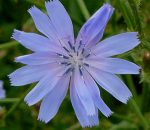 Chicory is a biennial to perennial herbaceous plant and member of the aster family, Asteraceae, that also includes sunflower, yarrow, and lettuce. It is native to Europe, Asia and Africa, and is naturalized throughout the US. Plants prefer neutral to alkaline well-drained soils in full sun but tolerate dryness and can be found growing along roadsides , railroads and in disturbed sites, waste areas, cultivated fields, and lawns.
Chicory is a biennial to perennial herbaceous plant and member of the aster family, Asteraceae, that also includes sunflower, yarrow, and lettuce. It is native to Europe, Asia and Africa, and is naturalized throughout the US. Plants prefer neutral to alkaline well-drained soils in full sun but tolerate dryness and can be found growing along roadsides , railroads and in disturbed sites, waste areas, cultivated fields, and lawns.
Description: Plants have upright branched stems that are green to reddish brown and produce a milky sap when cut. Basal leaves two to six inches long form a rosette, have rough hairs on both sides, and have shallowly toothed or deeply dissected margins. Smaller lanceolate leaves clasp the stem and are less lobed. One inch wide flowerheads appear from early summer into fall and have bright blue ray flowers. They may be terminal or produced in the leaf axils and usually open in the morning and close later in the day. The fruits are very small, dark brown, and wedge-shaped. A single plant can produce up to 3000 seeds in a growing season. Propagation is by seed and spreading roots.
Control: Pull or cut seedlings and larger plants as soon as possible being careful to dig deeply enough to remove as much of the root as possible to prevent resprouting. Alternatively, plants can be cut or mowed and the ground covered with a dense mulch such as newspaper or cardboard for one growing season. In severe cases herbicides can be used; 2,4-D, dicamba, and picloram give excellent results while glyphosate does not.